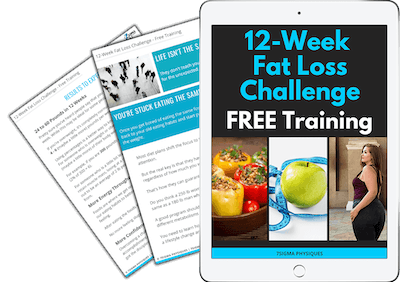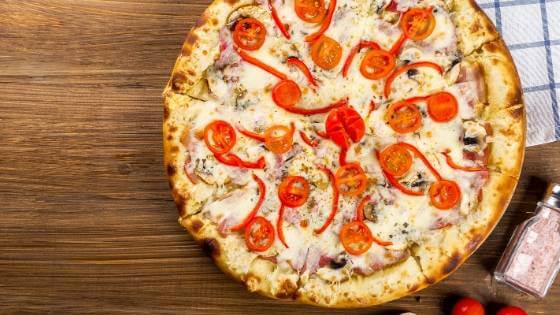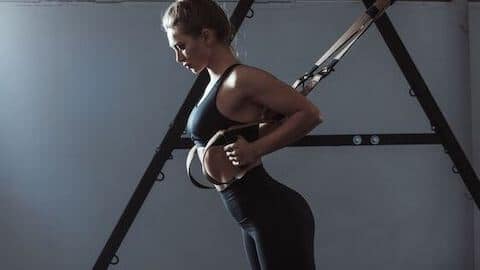If overthinking fun ways to open this blog post burned calories, I’d be stage lean.
Ba dum tsss!
Anyway, here are a few signs that your calories might be too low, lower limits for calories and macros, common nutrient deficiencies, and other ways of creating a calorie deficit.
Table of Contents
How To Tell If Your Calories are Too Low
Besides the obvious sign of feeling like a grouchy zombie, other symptoms include hair loss, irregular menstrual cycle, low sex drive, and sleep problems.
- Hair Loss
Even though it’s normal to lose a few strands of hair daily, losing more than usual can be a sign of low calories.
People on extremely low-calorie diets tend to be deficient in the nutrients needed to maintain proper hair health, such as biotin and iron. (1)
- No Menstrual Cycle
Women can experience amenorrhea – the absence of menstruation – when calories get too low.
Many female physique competitors experience this when their body fat percentage and calories get too low. (2)
However, this is only temporary, and your menstrual cycle should come back to normal after the dieting period is over.
- Low Sex Drive
Low body fat percentage, calories, and dietary fat will cause hormonal imbalances that will affect sex drive.
- Sleep Problems
Studies (3) have shown that very low-calorie diets can prevent you from having good quality sleep, including taking longer to fall asleep and spending less time in deep sleep.
Combine this with the large amount of caffeine athletes take during contest prep, and it’s goodbye, sayonara, and adiós to high-quality sleep.
- Fatigue
A very obvious one is fatigue.
You will feel remarkably tired, both physically and mentally, when your calories and body fat percentage get very low.
Explore More: Metabolic Adaptations to Weight Loss
Start your journey to losing 24-60 pounds in just 12 weeks.
Get the free 12-Week Fat Loss Challenge Training Guide!

Lower Limits for Calories and Macros
Calories
Once your calories get below 10 times your body weight in pounds, it may be a good idea to create a deficit by increasing cardio instead.
For example, that would be 1500 calories for someone who weighs 150 lb (150 x 10 = 1500).
While it’s okay and sometimes necessary for physique athletes to go below 10 times their body weight.
Athletes that go below this threshold should pay close attention to how they’re feeling, their recovery and performance, and maybe add more frequent refeed days and diet breaks.
Macros
- Protein: 1 g per pound of body weight.
The least amount of protein for someone who is very lean and doing resistance training should be 1 g per pound of body weight.
Adequate protein intake will be essential for maintaining lean body mass.
For example, someone who is very lean at 150 lb should consume no less than 150 g of protein per day.
Explore More: How Much Protein Can Your Body Absorb in One Meal?
- Fats: 40 – 50 g
Fats are an essential nutrient needed for hormonal balance, storing energy, and maintaining brain health and function. Therefore, you shouldn’t go below 40 g per day.
Without enough healthy fats, you can start running into some health and hormonal issues, like the ones I mentioned earlier.
The older you are, the higher in the range you should be.
- Carbs: 50 – 60 g for physique athletes or zero if you’re on Keto.
When carbs get this low, it would be smart to have them around your workout.
This will help prevent fatigue and help you perform better, which is important for muscle retention.
At this point, you should also consider carb cycling and having refeeds with two or three times the amount of carbs.
Since carbs are not an essential nutrient – we can survive without them – it’s okay to go down to zero. Some coaches actually prefer to have their athletes go keto rather than have them eat this little carbs.
Common Nutrient Deficiencies Due To Low Calories
When calories get too low, it can become difficult to get some of the necessary nutrients, which can affect your overall well-being and body composition.
- Zinc
Low amounts of zinc can affect proper thyroid function, which can lead to a significant drop in calorie expenditure, slower than normal heart rate, constipation, and menstrual irregularities for female athletes. (4, 5)
Studies (6) showed an increase in RMR – Resting Metabolic Rate – of 194 calories for a person supplementing with zinc for four months and an increase of 527 calories for another supplementing with zinc for only two months.
- Iron
Low levels of iron can have a negative effect on strength.
A study (7) on a group of female volleyball players showed that those who were supplementing with iron had greater strength in a series of barbell lifts compared to those who weren’t.
- Vitamin D
Most people are deficient in vitamin D without even being in a caloric deficit. A deficiency in this vitamin can lead to rickets in children and osteoporosis in adults. (8)
Vitamin D can be obtained from sunlight exposure; however, if you happen to work in a closed environment and don’t get much sunlight, you could get it in supplement form.
- Calcium
Calcium is crucial for bone health.
This nutrient is often found in dairy products, such as milk, cheese, and greek yogurt, but can also be found in supplement form.
I typically get my daily dose of calcium from unsweetened almond milk.
Consider Adding Cardio
When calories get too low, you could start increasing the number of LISS (low-intensity steady-state cardio) sessions that you do so you don’t compromise your nutrient intake.
Why LISS and not HIIT?
High-intensity interval training (HIIT), just like resistance training, uses more carbohydrates for fuel during the session and requires more recovery time than LISS.
Therefore, having too many HIIT sessions when you’re super lean can have negative effects on recovery and hinder performance in your workouts.
LISS, on the other hand, burns mostly fat during the session and doesn’t require too much recovery.
Explore More: Does Fasted Cardio Burn More Fat?
If you’re ready to start your weight loss journey, the 12-Week Fat Loss Challenge is the place to start!

This plan helps men and women lose fat without starving themselves or giving up their favorite foods.





